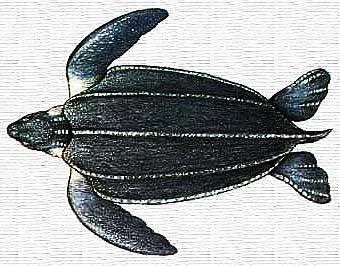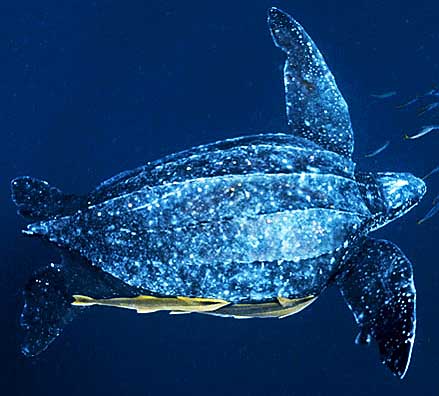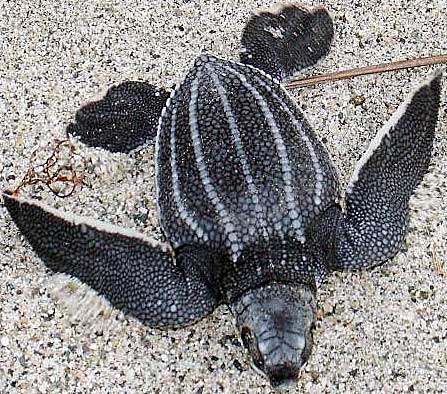Leatherback Sea Turtle – Largest Turtle, Farflung Reptile

Traveling Reptile
The leatherback sea turtle is a deep sea species that is only rarely found in shallow bodies of water. It has perhaps the greatest distribution of any reptile. It is found in all tropical oceans (and in the Mediterranean Sea), and it also ventures into the cold temperate waters around Newfoundland, Iceland, Norway, South Africa, New Zealand, and Alaska. It nests on tropical and subtropical shores.
The Shell or Carapace
Its smooth, streamlined shell is teardrop shaped, up to about 8 ft (2.5 m) long, has seven lengthwise ridges, and is covered with leathery skin. It doesn’t have any large structural bones but has hundreds of small bones that lie just under the leathery skin. The head also lacks scales and has a prominent tooth-like cusp on each side of the upper jaw. The shell and skin are generally black with scattered white or yellow blotches or spots. The belly is predominately white with scattered dark blotches or spots. The front limbs are paddle-like and lack claws. The largest individual turtle ever recorded was a leather back which was 9 ft (3 m) long and weighed 2016 lbs (914 kg). It drowned in fishing lines in the UK in 1988 and the body is now on display at the National Museum Cardiff.

A Day in the Life
Leatherback sea turtles make extensive migrations between feeding and nesting areas. Individuals have been found more than 3,100 miles (5,000 km) away from where they were first identified, and some have traveled an average of more than 19 miles (30 km) per day for weeks at a time. Feeding takes place in both cold and warm water environments, in large part because leatherbacks can maintain body temperatures above environmental temperatures. Body heat generated by muscle activity is lost very slowly due to the thermal inertia of the large body, excellent insulative properties of the oily skin, and countercurrent circulatory system in the limbs which keeps the heat in the body’s core. Leatherbacks sometimes aggregate, probably in association with feeding (e.g., on schools of jellyfish). They also are capable of making dives to depths of more than 3,300 ft (1,000 m) to reach food sources. They are active both day and night, although diving activity is increased at night. As they leave the nest, hatchlings are attracted to open, highly illuminated areas (usually the open sea).
Diet
Leatherbacks are almost completely carnivorous, preferring oceanic jellyfish. However, they also consume hydrozoans, snails, bivalves, octopi, squid, amphipod crustaceans, crabs, sea urchins, tunicates, and small fish, as well as algae, kelp, and sea grasses. Unfortunately, plastic bags or balloons dumped in the ocean by humans are often mistaken for jellyfish and, if consumed, can block the gastrointestinal tract, causing the turtle’s death.

Starting out small
Nesting
Nesting occurs on a great number of tropical beaches. The female digs a huge body pit with both front legs and hind limbs, and then excavates the actual nest cavity with her hind feet. Once the eggs are laid, the opening to the nest cavity is covered with sand by the hind limbs, and eventually the forelimbs are also used to fill the body pit. Most hatchlings leave the nest at night. Sex is determined by temperature during the middle third of incubation, with only females produced at high temperatures and only males at low ones. Population estimates suggest that this species has declined by more than 70% in less than one generation. Egg poaching has been the primary reason for the decline in this species, although adults are also harvested in many areas for their flesh and/or the oil in their shells.
